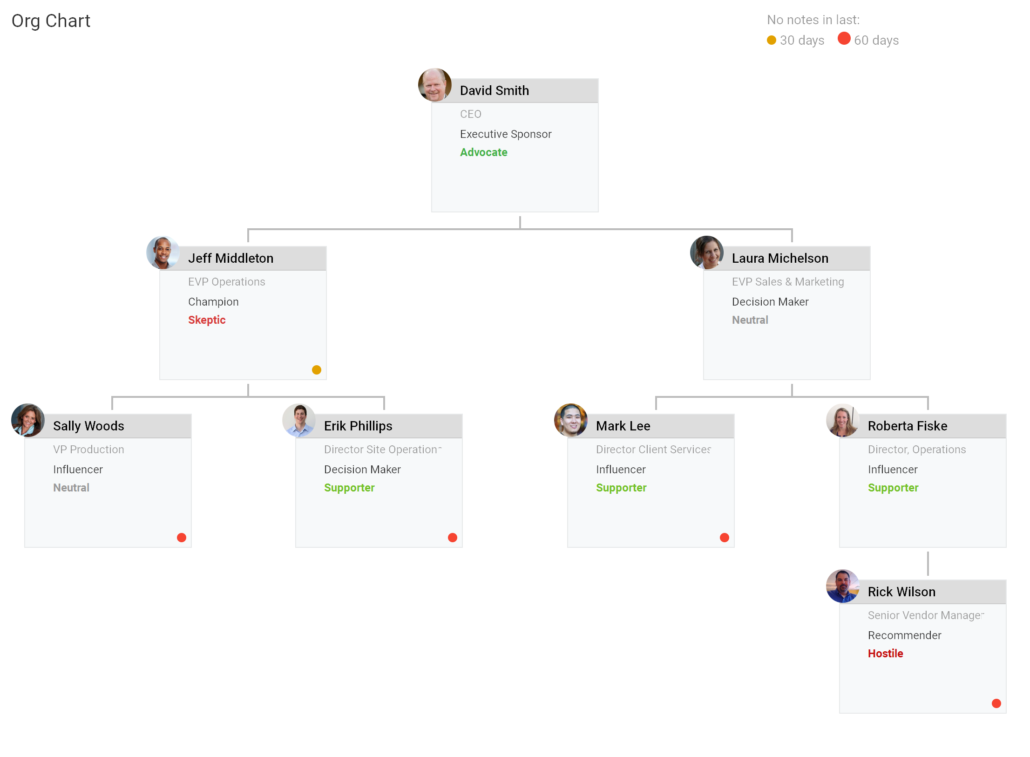3 Reasons to Update Your Customer Org Charts
in Customer Engagement /Be honest: When was the last time you took a long look at your customers’ org chart? We’ve seen too many B2B companies establish customer org charts early in the relationship — and then never look at them again.
On the surface, org charts may seem like busy work. But they’re the kind of work you need to do consistently to build customer engagement. Org charts are an exercise in stakeholder mapping, which you need for:
- Influence: Decisions are usually made by a cohort of customers. Make sure you know them all.
- Intelligence: When you can see the dynamics within your customers’ organization, you can better serve individual and enterprise needs.
- Resilience: When your relationships go beyond a single champion within the organization, you’re much less vulnerable to inevitable personnel shifts.
In this post, we’ll take a closer look at all the reasons listed above, and cover a few best practices for stakeholder mapping through detailed org charts.

Influence
According to an in-depth analysis of buyers and sellers in the B2B world, an average of 6-7 decision makers influence every B2B purchase. So it’s simply not enough to have one or two strong contacts within your customers’ organizations — you need to develop a coalition of champions from across the organization.
Your coalition will be different depending on the services you provide. If you sell software, for example, you need buy-in not only from day-to-day users, but also from procurement, the C-suite, and internal IT, to name a few. Your org chart will help you visualize the relationships within the organization, so you can cultivate the right client relationships along the way. In this sense, your customers’ org charts help you build your own, by making sure you have the right team in place to meet the variant needs of individual decision-makers, influencers, champions, and implementation partners in your customer’s organization.
Org charts cement your influence by making sure you invite the right stakeholders to the right checkpoints at the right time. In doing so, you’re increasing your reach within an organization while also helping your direct contacts manage their internal partners, whether it’s their leadership or their key collaborators.
Intelligence
One of your jobs as a key account manager is to know your clients better than anyone. Org charts can give you all sorts of insights and leads in this pursuit. They do this both by visualizing both vertical and horizontal relationships.
Vertically, org charts show you who reports to whom — and what the pathway for advancement is for individuals within your customer’s organization. This is key for understanding how to make your direct contact’s life easier. For example, when you can see the managers to whom they must demonstrate value, you can help arm your direct contacts with the results and messages they need in order to look good to their leadership — and get buy-in for their projects. (These are your projects, too, so it should be clear why this serves you well.)
Org charts also give you insight into your direct client’s goals — what’s the path forward for them? If you can help your clients not only meet their deadlines and execute their deliverables, but also grow their careers, you’ll have a champion for life — and that champion will be more and more influential as they ascend the ladder.
Org charts are also important for the horizontal picture — how different functions or departments collaborate within the overall structure of the organization. This information again helps you be more proactive for your direct contacts, by helping them manage lateral stakeholders in the organization.
Big picture, the org chart serves as a lens into the organization’s values as a whole, since companies tend to build structures and hierarchies based on their strategic goals and overarching values. They also give you a forward-facing view into where the organization is heading, so you and your team can work proactively to offer proactive, integrated B2B services.
Resilience
If your “in” with a customer rests entirely with one person, and that person leaves, where does that leave you? Worst case scenario, relying too heavily on one client contact can leave you out of a client.
The more integrated you are — which means multifunctional relationships with stakeholders across the horizontal and vertical org chart axes — the more you’ll engage the customer at an enterprise level, building resilience as individuals leave or initiatives come to a close. Enterprise-level engagement tends to unearth new business opportunities at every turn.
Best Practices for Stakeholder Mapping
We say all the time that customer-centricity can’t just be a value you state in a strategy deck somewhere. Customer centricity requires infrastructure.
Org charts are infrastructure for stakeholder mapping. They give you clear horizontal and vertical visualizations for the structure in your clients’ organizations. They give you influence, intelligence, and resilience — and each of those things builds on each other to form broad and deep customer engagement.
So how do you make org charts work for you? The best org charts are:
- Detailed: Make sure you capture the nuances of internal relationships. People don’t have to be direct supervisors to be strong influencers.
- Dynamic: Things can shift quickly when it comes to personnel and structure. Make sure you’re checking in regularly and capturing any changes.
- Visible: Everyone at your organization needs to be able to see the org chart for your customers in order for you to be able to offer integrated B2B services.
- Tech-enabled: The right key account management software will give you templated org charts to help you maintain this detailed, dynamic, highly visible tool for your teams, whether or not they’re directly customer-facing.
Conclusion
Org charts may seem like busy work — but in fact, they’re critical work. Org charts help you build influence within your customer’s organization; they give you intelligence you can use to broaden your engagement; and they help you build enterprise-level engagement for greater resilience over time. To see how Kapta can help you create dynamic, detailed, highly visible org charts, schedule a personal demo today.






